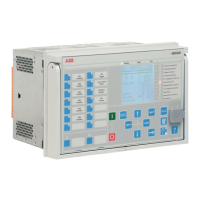Once activated, each timer activates its START output. Depending on the value of
the
Operating curve type
setting, the time characteristics are according to DT or
IDMT. When the operation timer has reached the value of
Operate delay time
in the
DT mode or the maximum value defined by the inverse time curve, the OPERATE
output is activated.
When the programmable IDMT curve is selected, the operation time characteristics
are defined by the parameters
Curve parameter A
,
Curve parameter B
,
Curve
parameter C
,
Curve parameter D
and
Curve parameter E
.
The shortest IDMT operation time is adjustable. The setup can be done
with a global parameter in the HMI menu: Configuration > System >
IDMT Sat point. More information can be found in
Chapter 11 General
function block features
in this manual.
If a drop-off situation happens, that is, a fault suddenly disappears before the
operation delay is exceeded, the timer reset state is activated. The functionality of
the timer in the reset state depends on the combination of the
Operating curve
type
,
Type of reset curve
and
Reset delay time
settings. When the DT characteristic
is selected, the reset timer runs until the set
Reset delay time
value is exceeded.
When the IDMT curves are selected, the
Type of reset curve
setting can be set to
"Immediate", "Def time reset" or "Inverse reset". The reset curve type "Immediate"
causes an immediate reset. With the reset curve type "Def time reset", the reset
time depends on the
Reset delay time
setting. With the reset curve type "Inverse
reset", the reset time depends on the current during the drop-off situation. If
the drop-off situation continues, the reset timer is reset and the START output is
deactivated.
The "Inverse reset" selection is only supported with ANSI or
programmable IDMT operating curves. If another operating curve type
is selected, an immediate reset occurs during the drop-off situation.
The
Time multiplier
setting is used for scaling the IDMT operating and reset times.
The setting parameter
Minimum operate time
defines the minimum desired
operating time for IDMT. The setting is applicable only when the IDMT curves are
used.
The
Minimum operate time
setting should be used with great care
because the operation time is according to the IDMT curve, but always
at least the value of the
Minimum operate time
setting. For more
information, see
Chapter 11 General function block features
in this
manual.
The timer calculates the start duration value START_DUR, which indicates the
percentage ratio of the start situation and the set operating time. The value is
available in the monitored data view.
Blocking logic
There are three operation modes in the blocking function. The operation modes are
controlled by the BLOCK input and the global setting in Configuration > System >
Blocking mode which selects the blocking mode. The BLOCK input can be controlled
by a binary input, a horizontal communication input or an internal signal of the IED
program. The influence of the BLOCK signal activation is preselected with the global
setting
Blocking mode
.
The
Blocking mode
setting has three blocking methods. In the "Freeze timers"
mode, the operation timer is frozen to the prevailing value. In the "Block all" mode,
the whole function is blocked and the timers are reset. In the "Block OPERATE
1MRS757644 H
Protection functions
620 series
Technical Manual
305

